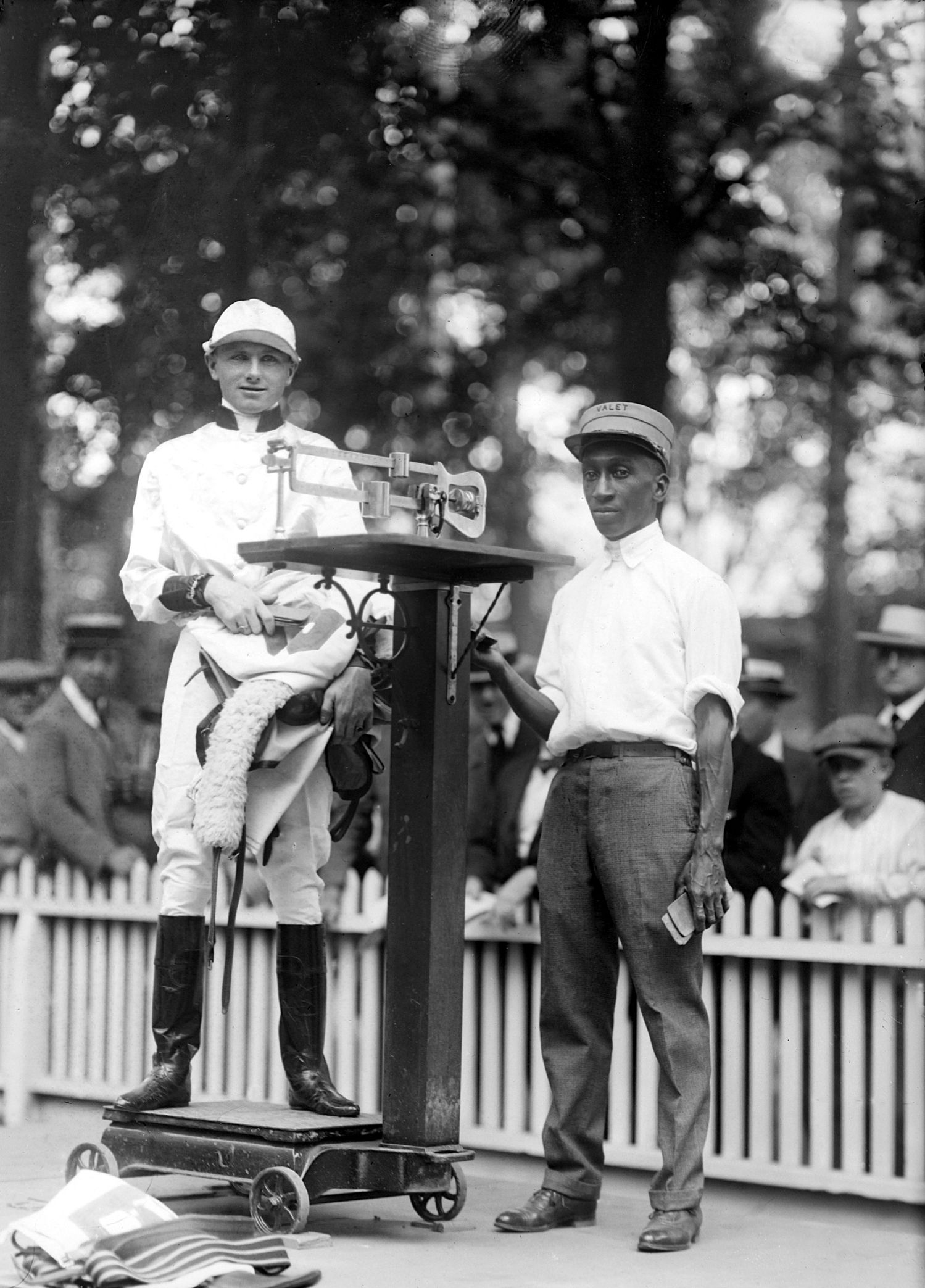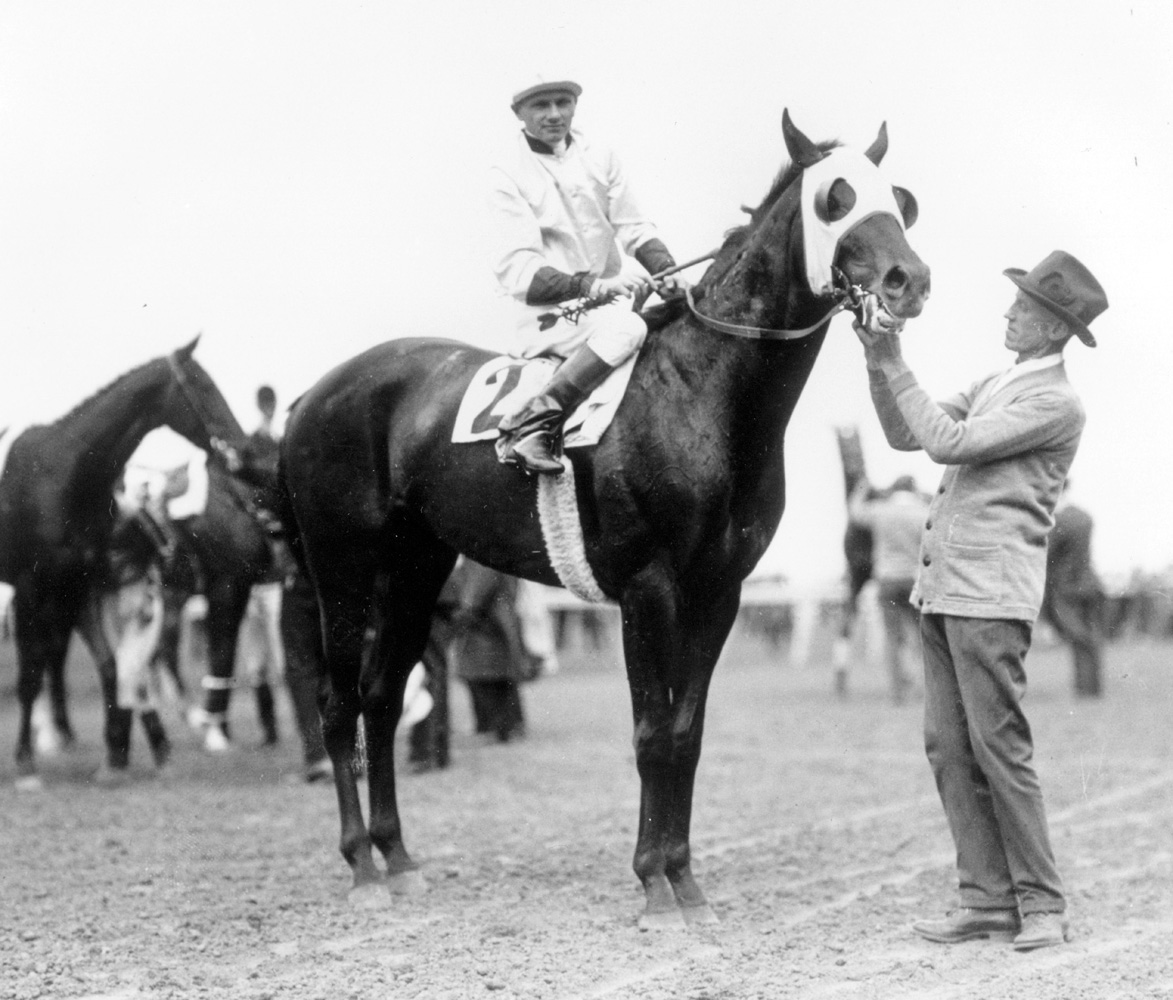Sande was a Dandy: Hall of Famer was one of the most accomplished jockeys of all time

Earl Sande won nine Triple Crown races in his remarkable career
By Brien Bouyea
Hall of Fame and Communications Director
Throughout the 1920s — an era commonly referred to as the Golden Age of Sports — Earl Sande occupied a place alongside Babe Ruth, Jack Dempsey, Bobby Jones, Bill Tilden, and Red Grange in the pantheon of America’s most revered athletes.
Hailed by many as the greatest jockey of his time, Sande won nine Triple Crown races, including a sweep of the series in 1930 with Gallant Fox. He piloted some of the greatest racehorses of his era and was a favorite among scribes of the day, immortalized as the “Handy Guy” by newspaperman Damon Runyon. Sande later enjoyed success as a trainer and was enshrined in the National Museum of Racing’s Hall of Fame as a member of the inaugural class of 1955.
Born Nov. 13, 1898, in Groton, South Dakota, Sande grew up in American Falls, Idaho. He started out as a bronco buster in his youth and rode quarter horses before heading to Louisiana and transitioning to thoroughbreds in 1918. He rode his first winner, Prince S., Jan. 21, 1918 at Fair Grounds in New Orleans, and it didn’t take long for owners and trainers to recognize and covet Sande’s special abilities. He signed as a contract rider for the formidable stable of Commander J. K. L. Ross in 1919 and was soon riding standouts for Ross such as future Hall of Famers Sir Barton and Billy Kelly. Late in 1920, Sande was signed by trainer Sam Hildreth to ride for Harry F. Sinclair’s powerful Rancocas Stable. He was suddenly at the top of his profession.
In 1921, Sande led all North American jockeys in earnings for the first of three times in the decade. He was again the leader in 1923, setting a record of $569,394, which stood for 20 years. Sande was also atop the earnings list in 1927, and he ranked among the top five nationally nine times in his illustrious career.
Several of the horses Sande rode were among the sport’s best, including future Hall of Fame members Crusader, Exterminator, Grey Lag, Sarazen, and Zev, as well as the aforementioned Gallant Fox, Sir Barton, and Billy Kelly. Sande also won a race with the mighty Man o’ War and always considered the original Big Red to be the greatest horse he ever rode.
In the 1920s, Sande won the Kentucky Derby with Zev (1923) and Flying Ebony (1925), and the Belmont Stakes with Grey Lag (1921), Zev (1923), Mad Play (1924), and Chance Shot (1927). Sande won a total of 39 stakes races in his record-setting year of 1923, including 10 with Zev. Sande was also aboard Zev when he won a famous match race on Oct. 23, 1923, against Papyrus, the Epsom Derby winner, before a crowd of more than 50,000 at Belmont Park.
Increasing weight became a problem for Sande in the late 1920s and forced him to temporarily retire in the fall of 1928. He transitioned to owning and training horses with mixed results while also occasionally riding his own horses. Sande’s glory days in the irons appeared to be through, but Gallant Fox soon entered the picture.
In late 1929, Belair Stud owner William Woodward, Sr. sought out Sande to ride “The Fox of Belair” for his upcoming 3-year-old campaign. A son of Sir Gallahad III out of the Celt mare Marguerite, Gallant Fox had won only twice in seven starts as a juvenile but showed promise with victories in the Flash and Cowdin stakes.
Sande liked what he saw in Gallant Fox and agreed to ride for 10 percent of the colt’s earnings instead of a fixed fee. Sande’s decision was a brilliant one, as Gallant Fox delivered one of the most remarkable campaigns in racing history with a record of 9-1-0 from 10 starts in 1930. He became the second horse to win the Triple Crown, while also adding victories in the Wood Memorial, Dwyer, Arlington Classic, Saratoga Cup, Lawrence Realization, and Jockey Club Gold Cup.
Following Gallant Fox’s victory in the Derby, Runyon began to type:
Say, have they turned back the pages,
Back to the past once more …
Back to the racing ages
To a Derby out of the yore?
Say, don’t tell me I’m daffy
Ain’t that the same old grin?
Why, it’s that Handy Guy Named Sande
Bootin’ a winner in.
Gallant Fox’s only loss of 1930 was the infamous Travers Stakes when he did not take well to the muddy Saratoga track as Jim Dandy pulled off one of the most stunning upsets of the century to win at 100-1 odds. Gallant Fox earned $308,275 in 1930, a single-season mark that was not eclipsed for 16 years. Sande’s cut of the purse money was more than $30,000, a considerable sum in the aftermath of the 1929 stock market crash.
A stomach ailment and continued weight issues forced Sande to miss all of 1931, but he returned to the saddle for 78 races in 1932, winning 13, before retiring again at the end of the Saratoga meeting.
Sande again turned his attention to training. In 1938, was North America’s leading trainer by earnings with $226,495. Much of Sande’s success as a conditioner that year was thanks to his champion 3-year-old colt Stagehand, winner of the unique double of the Santa Anita Derby and Santa Anita Handicap, as well as the Empire City Handicap and Narragansett Special, among others. Stagehand remains the only 3-year-old to win the Santa Anita Handicap.
In 1953, at the age of 55, Sande attempted another comeback as a jockey. He won once from 10 mounts before giving up riding for good. Sande finished his riding career with 968 wins and purse earnings of $2,998,065. The one race he won that year took place Oct. 14 at Jamaica Racetrack when rode Miss Wessie past Eddie Arcaro and odds-on favorite Will Be There. According to the Morning Telegraph, Sande’s final victory as a jockey “will long be remembered by all who were at Jamaica that afternoon. The ovation given the wizened, graying veteran has probably never been equaled on an American racetrack.”
Two years later, Sande was part of the inaugural class inducted into the National Museum of Racing’s Hall of Fame. Sadly, the beloved Sande became a recluse following his final retirement from riding. He had financial troubles from failed bloodstock investments and lived in a single room above a bar on Long Island for several years before eventually moving to Oregon to be near his father.
Stories indicated that Sande was living as a hermit because of his stubborn nature. Officials at the New York tracks offered him considerable pay each season just to be a greeter and an ambassador for the sport. Other tracks and racing organizations also offered him a variety of positions, but Sande viewed it as charity and refused such overtures.
“Sande turns down money like it was going to hurt,” New York racing official Bob Kelley said in a 1958 interview. “It’s in racing’s interest for him to have money. People who don’t know the story will see him and they’ll say what a cold racket we run. We don’t take care of our own. We’ve done everything humanly possible to straighten him out, but you just can’t force a man to take money. If he takes it in any manner except his talent, he figures he is admitting defeat.”
On Aug. 19, 1968, at the age of 69 and far from the limelight of his racing days, Sande died at a nursing home in Oregon. He hadn’t been in the public eye for years and writer Jimmy Breslin said the story of Sande’s final years “ranks with the saddest in sports.”
Earl Sande, one of the most famous and accomplished athletes of his era struggled through a heartbreaking final chapter in life, but his remarkable achievements on the racetrack endure, as does his legacy as one of the greatest of all American jockeys.
EARL SANDE

Born: Nov. 13, 1898, Groton, South Dakota
Died: Aug. 19, 1968, Jacksonville, Oregon
Career Statistics (1918 through 1953)
Mounts — 3,673
Wins — 968
Win Percentage — 18.8%
Earnings — $2,998,065
Notable:
- Led all North American jockeys with earnings 1921, 1923, 1927
- Won the Kentucky Derby 1923, 1925, 1930
- Won the Preakness Stakes 1930
- Won the Belmont Stakes 1921, 1923, 1924, 1927, 1930
- Won the Jockey Club Gold Cup 1921, 1922, 1927, 1930
- Inducted into the Hall of Fame 1955




